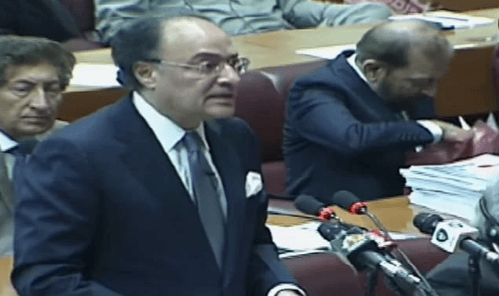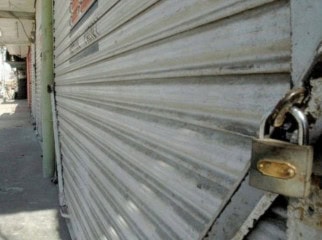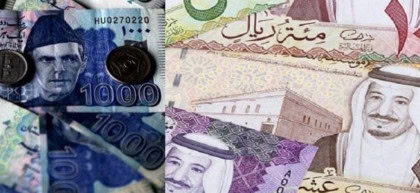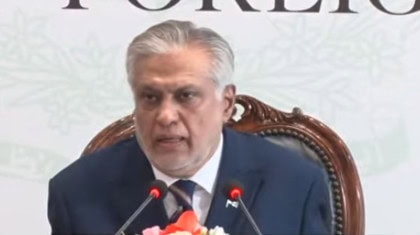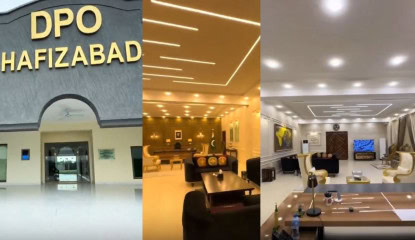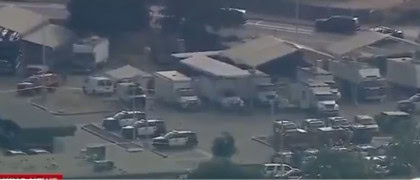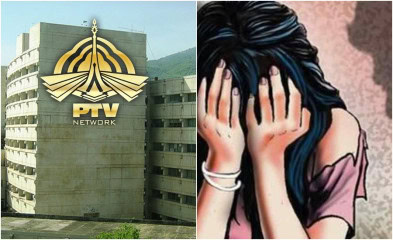ISLAMABAD – The Pakistan federal government on Tuesday (today) unveiled its federal budget for the fiscal year 2025-26, and set 4.2 percent GDP goal while easing burden on the salaried class and employees.
Federal Minister For Finance Senator Muhammad Aurangzeb delivered the budget speech. Prime Minister Shehbaz Sharif was also present there.
Opposition members continued to protest against the government and rejected the budget.
Senator Muhammad Aurangzeb, the Federal Finance Minister, began his budget speech after receiving permission from the Speaker, expressing gratitude to the Prime Minister and other political leaders. He said the budget was being presented under extraordinary circumstances, at a time when the nation had shown remarkable unity. “The unity of the nation against India will be remembered as a golden chapter in history,” he remarked.
The finance minister stated that the government’s focus was now on economic stability and growth. “With the same sincerity and resolve, we will stabilize the economy and ensure public welfare,” he said, adding that over the past one and a half years, Pakistan had embarked on a path of growth and successful economic reforms, strengthening the future while stabilizing the economy.
“We aim to build an economy that directly benefits every segment of society and brings development to every doorstep,” he emphasized.
He shared that during this period, progress was achieved in various sectors, and there was hope that remittances would reach $37 billion by the end of the current fiscal year, signaling that the country was on the path to sustainable development.
Highlighting the performance of the Federal Board of Revenue (FBR), Aurangzeb said significant progress had been made in revenue collection over the past 18 months. “We were missing out on more than half of our tax potential, and bridging this gap was essential. Without transforming the FBR, improving the economy was impossible,” he noted.
He added that under the Prime Minister’s supervision, a foundational plan was approved, leading to an increase in revenue. “We collected Rs 78.4 billion in difficult recoveries and resolved issues through ADR in the courts, which added Rs 77 billion to the national exchequer.”
Major reforms in power sector underway
Aurangzeb stressed the need for deep and structural reforms in the power sector, which had already resulted in a reduction of billions in losses. He noted that the privatization of electricity companies in Faisalabad, Gujranwala, and Islamabad had been completed.
He further informed that the National Transmission and Dispatch Company (NTDC) had been divided into three separate entities and that professionals of international standards would be appointed in these institutions.
“We have formed non-political boards, which have helped reduce expenses and losses by Rs 140 billion,” he said, adding that the process for establishing a competitive energy market would begin within the next three months.
The federal government on Tuesday presented the budget for fiscal year 2025–26 in Parliament, proposing a total outlay of Rs17.573 trillion with a projected budget deficit of Rs6.501 trillion, amounting to 5% of GDP.
Key relief measures
A 10% increase in salaries of federal government employees and a 7% hike in pensions has been proposed.
Significant reductions in income tax rates are proposed across all salary slabs for the salaried class.
Grade 1 to 16 employees are proposed to receive a 30% disparity allowance.
Income tax for salaried individuals earning Rs600,000 to Rs1.2 million annually is proposed to be reduced from 5% to 1%, cutting the tax from Rs30,000 to just Rs6,000.
For those earning up to Rs2.2 million, the tax rate is proposed to be reduced from 15% to 11%.
For income up to Rs3.2 million, a reduction from 25% to 23% has been proposed.
Major allocations and revenue targets
Total expenditures for FY26 are estimated at Rs17.573 trillion.
Gross revenue target is set at Rs19.298 trillion, while net revenue is estimated at Rs11.072 trillion.
The Federal Board of Revenue (FBR) has been tasked with collecting Rs14.131 trillion in taxes.
Non-tax revenue target is fixed at Rs5.147 trillion.
Privatization proceeds are estimated at Rs87 billion.
Defence spending is proposed at Rs2.550 trillion.
Current expenditures stand at Rs16.286 trillion, of which:
Rs8.207 trillion is allocated for interest payments on debt,
Rs1.055 trillion for pension payments,
Rs1.928 trillion for grants and provincial transfers,
Rs1.186 trillion for subsidies, and
Rs289 billion for emergency and disaster-related spending.
Development spending
Total development and net lending is estimated at Rs1.287 trillion, including:
Rs1 trillion for the Public Sector Development Programme (PSDP),
Rs287 billion for net lending.
Economic projections for FY2025-26
GDP growth target: 4.2%
Inflation target: 7.5% (annual average)
Exports target: $35.3 billion
Imports target: $65.2 billion
Remittances target: $39.4 billion
Current account deficit: $2.1 billion, equivalent to -0.5% of GDP
Total export of goods and services: $44.9 billion
Total imports of goods and services: $79.2 billion
Sector-wise targets
Agriculture growth: 4.5%
Major crops: 6.7%
Other crops: 3.5%
Cotton ginning: 7%
Livestock: 4.2%
Forestry: 3.5%
Fishing: 3%
Industrial sector: 4.3%
Manufacturing: 4.7%
Large-scale: 3.5%
Small-scale: 8.9%
Slaughtering: 4.3%
Electricity, gas & water supply: 3.5%
Construction: 3.8%
Services sector: 4%
Wholesale & retail trade: 3.9%
Transport, storage & communication: 3.4%
Information & communication: 5%
Financial and insurance activities: 5%
Gross investment target: 14.7%
Fixed investment: 13%
Public investment (including general government): 3.2%
Private investment: 9.8%
National savings: 14.3%
Govt raises defence budget
The federal government raised the defence spending to Rs2,550 billion for next fiscal year 2025-26, 20 percent higher than the Rs2,122 billion in the previous year, following a military escalation with India in May 2025.
Finance Minister Muhammad Aurangzeb presented the budget in the National Assembly, emphasizing on economic stability in the country.
Pakistan’s defence budget has seen consistent growth over the past several fiscal years. In the outgoing FY2024-25, the allocation reached Rs 2,122 billion, marking an 18% increase from the previous year. Before that, FY2023-24 recorded a 15% rise, with the budget standing at Rs 1,804 billion, up from Rs 1,563 billion in FY2022-23, which had seen a 14% expansion.
The preceding year, FY2021-22, witnessed a more modest 6% increase, bringing the budget to Rs1,370 billion.
In his budget speech, the finance minister that this budget is being presented at a very important and historic moment. The nation demonstrated unity during the recent Pakistan-India war. I congratulate the military and political leadership on the success in the recent war. Pakistan’s stature has risen in the international community.
He said that by utilizing national determination and unity, our focus is now on economic development. Economic stability has been achieved through economic reforms. Several measures have been taken to improve the economy, inflation has significantly decreased, and remittances stood at 36 billion dollars over the past 10 months.
Tax relief for corporate sector, real estate in Budget 2025–26
Finance Minister Muhammad Aurangzeb said the government has proposed a 0.5 percent reduction in super tax for companies with annual earnings between Rs200 million and Rs500 million. The move is aimed at easing the tax burden on mid-sized businesses.
The budget also proposes a reduction in withholding tax on property purchases. The standard rate is proposed to be cut from 4 percent to 2.5 percent. Similarly, the second tax slab would be reduced from 3.5 percent to 2 percent, and the third from 3 percent to 1.5 percent.
In a major shift for the real estate sector, the government has decided to abolish the 7 percent federal excise duty (FED) imposed last year on the transfer of commercial properties, plots, and houses.
To encourage home ownership, the government has announced a tax credit for houses measuring up to 10 marlas and flats up to 2,000 square feet. It also plans to promote mortgage financing as part of its broader housing policy.
Additionally, stamp duty on property purchases in Islamabad has been slashed from 4 percent to 1 percent, a step expected to boost real estate activity in the capital.
Family Pensions duration in Pakistan revised in major overhaul
The government unveiled major pension reforms as part of Budget 2024-2025, in bid to improve fiscal stability and ensure more sustainable pension system.
In a budget speech, Finance Minister Aurangzeb highlighted that over past decades, several executive orders led to changes in the pension scheme, which eventually put a lot of burden on the national kitty. To address this, the government is now implementing fundamental reforms.
Finance Minister said the primary goal of these reforms is to stabilize public finances and create a more equitable and efficient pension system.
Budget 2025-26
New measures include discouraging early retirement, linking pension increases to the Consumer Price Index to better reflect inflation, and limiting the duration of family pensions after the death of a spouse to ten years.
Furthermore, new reforms introduce restrictions on re-employment after retirement, requiring government employees to choose between receiving a pension or a salary if they return to work. These changes are expected to have major impact on government employees and pensioners in line with government’s broader efforts to strengthen fiscal management.
The announcement has been widely viewed as positive step towards ensuring long-term financial sustainability for the country. Experts believe these reforms will help improve the government’s financial health and contribute to economic stability in the years ahead.
Petrol prices to rise as carbon levy proposed in budget
Imposition of a carbon levy on petroleum products has been proposed in the federal budget for the fiscal year 2025-26.
Carbon levy of Rs 2.5 per liter is expected to generate around Rs 48 billion in the next financial year.
The levy on motor spirit and high-speed diesel will be doubled to Rs 5 per liter in the following fiscal year which will generate Rs96 billion in 2026-27.
In addition to the existing petroleum levy, a carbon levy of Rs 2 per liter (Rs 2,665 per metric ton) will be imposed on furnace oil. It will be enhanced to Rs 5 per liter in the following financial year.
For imposing carbon levy, the federal government will amend the Petroleum Products (Petroleum Levy) Ordinance 1961. It will boost revenue while addressing environmental concerns linked to fossil fuel consumption.
Govt proposes 18% tax on import of solar panels
The government also proposed imposition of 18 percent tax on the import of solar panels, a move that would increase the prices of the imported panels.
Federal Finance Minister Muhammad Aurangzeb presented the budget in the National Assembly with total outlay of Rs17.6 trillion.
The finance minister stated that to bring fairness to the sales tax system and address its long-standing flaws, several measures are being proposed.
He mentioned that to ensure a level playing field between imported and locally manufactured solar panels, it has been proposed to impose an 18% tax on the import of solar panels.
He added that this measure will play a key role in promoting Pakistan’s domestic solar panel industry.
Rs133bn for water resources, Rs18.5bn for education
Finance Minister Senator Muhammad Aurangzeb said Rs133 billion have been allocated for the Ministry of Water Resources, citing the need to counter India’s aggression and repeated violations of the Indus Waters Treaty. He said the funds would be used for improving water storage capacity and curbing wastage.
The government has also allocated Rs3.2 billion for Karachi’s K-IV water supply project, aimed at addressing the metropolis’s chronic water shortages.
Additionally, major allocations have been made for dam construction across the country.
These include:
Rs32.7 billion for Diamer Bhasha Dam
Rs35.7 billion for Mohmand Dam
Rs5 billion for three dams in Balochistan, including Awaran and Panjgur
Uniform tax on vehicles
The finance minister announced that the government is moving towards a uniform sales tax regime for all vehicles, including petrol, diesel, and hybrid models. Vehicles that were previously taxed below 18% will now be brought under the standard 18% sales tax rate, he said.
Furthermore, he revealed that courier and logistics companies delivering goods via e-commerce platforms will be required to collect and deposit 18% sales tax, to ensure tax compliance in the growing online market.
Revenue targets and spending
The government has set a non-tax revenue target of Rs5.147 trillion, while net federal revenue is projected at Rs11.072 trillion. The total federal expenditure is estimated at Rs17.573 trillion, of which a significant portion—Rs8.207 trillion—will go toward interest payments. Current expenditures are estimated at Rs16.286 trillion.
The government has proposed Rs1 trillion for the Public Sector Development Programme (PSDP), and Rs2.55 trillion has been allocated for national defense.
In the education sector, Rs18.5 billion have been earmarked for various initiatives. This includes:
Rs3 billion for the reconstruction of schools damaged by floods
Rs4.3 billion under the Prime Minister’s Youth Skill Development Programme, targeting the training of 161,500 youth
The budget reflects the government’s emphasis on infrastructure development, human capital investment, and fiscal discipline, while also preparing for external challenges such as water security and regional tensions.
Budget Summary
Economic Indicators
– GDP Growth: Projected at 3.9%.
– Inflation: Targeted at 12.3%.
– Fiscal Deficit: Aiming for 5.5% of GDP.
– Tax-to-GDP Ratio: Goal of 10% (currently 8.8%).
FBR Reforms:
– Digital Transformation: Implementation of AI-driven audit systems, e-invoicing, and digital tracking.
– Tax Compliance: Measures to reduce tax evasion and broaden the tax base.
Energy Reforms:
– Circular Debt: Plan to reduce by PKR 389 billion.
– Tariff Rationalization: Competitive pricing for power distribution.
– Renewable Energy: Push for solar/wind projects to cut import dependence.
Page 11 (Oil/Gas Exploration):
– Energy Security: Offshore exploration bids to reduce import reliance.
– Tight Gas Incentives: Pricing reforms to attract investment.
Privatization:
– PIA & DISCOs: Accelerated privatization of Pakistan International Airlines and power distribution companies.
– Non-Essential SOEs: Divestment of non-strategic state-owned enterprises.
Social Protection & Climate:
– BISP Expansion: Benazir Income Support Programme coverage increased by 15% for pregnant/lactating women.
– Climate Resilience: Allocation of PKR 16 billion for climate adaptation (flood management, water conservation)
IT Sector:
– Digital Governance: E-Government initiatives to improve public service delivery.
– IT Exports: Target of $25 billion by 2029.
(SMEs & Housing:
– SME Financing: PKR 47 billion allocated for credit access.
– Affordable Housing: Subsidized mortgage schemes for low-income groups.
Overseas Pakistanis:
– Remittance Incentives: Simplified banking channels; target of $31.3 billion remittances.
– Skill Training: Programs for returning expatriates.
SIFC:
– Special Investment Council: Fast-tracking projects in agriculture, mining, and IT under SIFC oversight.
Water Infrastructure:
– Dams & Canals: PKR 69 billion for flood control and irrigation efficiency (e.g., K-IV water project).
Health/Education:
– Healthcare: Upgrading 90 tertiary hospitals; preventive care initiatives.
– Education: 18.5% budget increase for skill development and ECE programs.
Tax Enforcement:
– Digital Monitoring: AI tools for tracking e-commerce transactions.
– Non-Filer Penalties: Stricter enforcement against tax evasion.
Debt Servicing:
– Debt Management: Liability reduction via buybacks; refinancing high-cost loans.
Summary of Key Budget Measures
– Fiscal Discipline & Growth
– Deficit Target: 5.5% of GDP.
– Revenue Mobilization: FBR reforms to raise tax-to-GDP ratio to 10% (digital systems, reduced exemptions).
– Debt Management: PKR 850 billion buyback plan; extend debt maturities.
Sectoral Reforms
– Energy: Cut circular debt by PKR 389B; tariff reforms; renewable energy push.
– Privatization: PIA, DISCOs, and non-essential SOEs to be sold.
– Agriculture: “Green Pakistan Initiative” with PKR 178B for climate-smart farming and e-wallet for subsidies.
– SMEs/Housing: PKR 47B for SME loans; affordable housing schemes.
Social Protection
– BISP: 15% expansion for vulnerable women; financial literacy programs.
– Pensions: Indexation to inflation for federal employees.
– Health: Upgrading 90 hospitals; PKR 21B for preventive care.
Digital Transformation
– E-Governance: Unified platforms for public services.
– IT Exports: Target of $25B by 2029; incentives for tech startups.
– E-Commerce: “Digital Services Tax” on foreign platforms; SME onboarding.
Infrastructure & Climate
– Water: PKR 69B for dams/canals; irrigation efficiency projects.
– Climate Resilience: PKR 16B for flood control; carbon levy on furnace oil.
– CPEC: Focus on rail/road connectivity under SIFC.
- Governance
– Federal Rightsizing: 10% reduction in non-essential posts.
– Judicial Reforms: Fast-track courts for tax disputes.
Major Allocations (PKR Billion):
– Health: 21
– Education: 18.5
– BISP: 592
– Climate: 16
– Energy Debt: 389
– Agriculture: 178
Challenges Addressed:
– Inflation control (12.3% target).
– Energy sector inefficiencies.
– Tax evasion (non-filer penalties).
– Climate vulnerability.
The 2025-26 budget prioritizes austerity, digital modernization, and export-led growth while expanding social safety nets. Success hinges on effective implementation of privatization and tax reforms.

